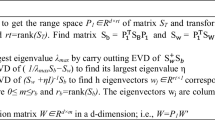Abstract
Linear Discriminant Analysis (LDA) technique is an important and well-developed area of image recognition and to date many linear discrimination methods have been put forward. Despite these efforts, there persist in the traditional LDA some weaknesses. In this paper, we propose a new LDA-based method called Block LDA (BLDA) that can outperform the traditional Linear Dicriminant Analysis (LDA) methods. As opposed to conventional LDA, BLDA is based on 2D matrices rather than 1D vectors. That is, we firstly divides the original image into blocks. Then, we transform the image into a vector of blocks. By using row vector to represent each block, we can get the new matrix which is the representation of the image. Finally LDA can be applied directly on these matrices. In contrast to the between-class and within-class covariance matrices of LDA, the size of the these covariance matrices using BLDA is much smaller. As a result, BLDA has three important advantages over LDA. First, it is easier to evaluate the between-class and within-class covariance matrices accurately. Second, less time is required to determine the corresponding eigenvectors. And finally, block size could be changed to get the best results. Experiment results show our method achieves better performance in comparison with the other methods.
Preview
Unable to display preview. Download preview PDF.
Similar content being viewed by others
References
Zhao, W., Chellappa, R., Rosenfeld, A., Phillips, J.: Face Recognition: A Literature Survey. Technical Report, CFAR-TR00-948, Univ. of Maryland (Revised 2002)
Turk, M., Pentland, A.: Eigenfaces for recognition. Journal of Cognitive Neuroscience 3, 71–86 (1991)
Yang, J., Zhang, D., Frangi, A.F., Yang, J.-y.: Two-dimensional PCA: a new approach to appearance-based face representation and recognition. IEEE Transactions on Pattern Analysis and Machine Intelligence 26, 131–137 (2004)
Belhumeur, P.N., Hespanha, J.P., Kriegman, D.J.: Eigenfaces vs. fisherface: Recognition using class specific linear projection. IEEE Trans. Pattern Anal. Machine Intel. 19, 711–720 (1997)
Yu, H., Yang, J.: A direct LDA algorithm for high-dimensional data with application to face recognition. Pattern Recognit 34, 2067–2070 (2001)
Loog, M., Duin, R.P.W., Haeb-Umbach, R.: Multiclass linear dimension reduction by weighted pairwise fisher criteria. IEEE Trans. Pattern Anal. Machine Intell. 23, 762–766 (2001)
Martinez, A.M., Kak, A.C.: PCA versus LDA. IEEE Trans. Pattern Anal. Machine Intell. 23, 228–233 (2001)
Foley, D.H., Sammon, J.W.: An optimal set of discrimination vectors. IEEE Trans. Comput. C-24, 281–289 (1975)
Fisher, R.A.: The use of multiple measurements in taxonomic problems. Ann. Eugenics 7, 178–188 (1936)
Huang, R., Liu, Q., Lu, H., Ma, S.: Solving the small sample size problem of LDA. In: Proceedings of the 16th International Conference on Pattern Recognition, vol. 3 (2002)
Liu, C., Wechsler, H.: Robust coding scheme for indexing and retrieval from large face databases. IEEE Trans. Image Processing 9, 132–137 (2000)
Liu, C., Wechsler, H.: A shape- and texture-based enhanced Fisher classifier for face recognition. IEEE Trans. Image Processing 10, 598–608 (2001)
Chen, L., Liao, H.M., Ko, M., Lin, J., Yu, G.: A new LDA-based face recognition system which can solve the small sample size problem. Pattern Recognit 33, 1713–1726 (2000)
Author information
Authors and Affiliations
Editor information
Editors and Affiliations
Rights and permissions
Copyright information
© 2005 Springer-Verlag Berlin Heidelberg
About this paper
Cite this paper
Nhat, V.D.M., Lee, S. (2005). Block LDA for Face Recognition. In: Cabestany, J., Prieto, A., Sandoval, F. (eds) Computational Intelligence and Bioinspired Systems. IWANN 2005. Lecture Notes in Computer Science, vol 3512. Springer, Berlin, Heidelberg. https://doi.org/10.1007/11494669_110
Download citation
DOI: https://doi.org/10.1007/11494669_110
Publisher Name: Springer, Berlin, Heidelberg
Print ISBN: 978-3-540-26208-4
Online ISBN: 978-3-540-32106-4
eBook Packages: Computer ScienceComputer Science (R0)




